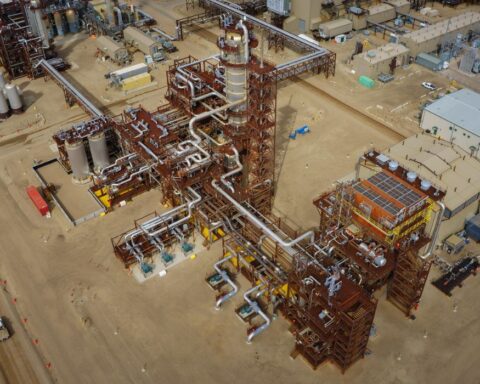Sitting at his desk in Montreal, BrainBox AI CEO Sam Ramadori frequently refers to the sleek corporate high-rises visible through his office window in the heart of the city’s business district. Gradually filling up again with people after the long pandemic hiatus, these towers are not just workplaces, but complicated architectural machines.
“If you look behind me, those towers have hundreds of rooms in them, each one of them kind of different,” he observes. “Some of them face the sun, some of them don’t, some of them are occupied or unoccupied.” These structures, moreover, are served by centralized heating and air-conditioning systems, which are fitted with hundreds of sensors, as well as software controllers designed to knit all the tech together, and typically run on natural-gas-powered boilers and chillers. (Building operations, including heating and cooling, account for roughly 27% of global carbon emissions, according to the International Energy Agency.)
BrainBox’s founders reckoned that what was missing, from a technical perspective, was data on what is happening on any given day: the number of bodies coming through the front doors, the weather, and utility rates. The firm built an artificial intelligence algorithm that uses past data about a building’s operations as well as weather patterns to make predictions about the amount of heating, ventilation or air conditioning (HVAC) required at any moment and then transmits this information to the controllers, ideally making the system as energy-efficient as possible.

“The AI is collecting data and learning,” says Ramadori, whose company recently completed a US$20-million deal with the Swiss engineering giant ABB and the province of Quebec that could see its technology deployed in 12,000 buildings across 4,700 cities. “It’s learning that at 8 a.m. in the morning, the sun is coming up and it’s hitting the windows on the south and east side of the building. Those rooms, relative to the ones on the other side of the building, are getting hot when it’s sunny outside, but when it’s cloudy, that doesn’t happen. It’s putting all this data together to understand what is happening in each room. You just have so many more opportunities to optimize.”
The firm claims that its autonomous artificial intelligence HVAC control technology can cut a building’s energy costs by a quarter and carbon emissions by up to 40%. BrainBox AI is tapping into an eager market that includes both property managers concerned about their expenses and investors interested in curbing building emissions with smart technology.
Friend or foe
AI – which is really a blanket term for a large family of predictive algorithms – has lately been careening down a steep slope on the technology hype cycle. The reputational dip comes after several years during which seemingly countless start-ups, venture capital funds and tech ventures were tripping over themselves to add machine learning or neural networks to their offerings. (Some AI systems are rules-based, in that they’re trained to find specific types of data, whereas others, like neural networks, discern patterns by sifting through huge data sets.)
The heavily scrutinized release last fall and winter of several versions of ChatGPT, an OpenAI “large language model,” stoked fears about the imminent arrival of what’s known, rather blandly, as “general artificial intelligence” – that is, machines that can basically think for themselves. A Google engineer got fired for predicting that rapid developments in AI would soon produce a “sentient” system. A New York Times tech reporter revealed that an AI chatbot running on a Microsoft platform had professed love and encouraged him to leave his wife. Stories have filled the media about students turning to ChatGPT to write assignments and software developers discovering that the algorithm is just as good at writing code as they are.
I wouldn’t like to devalue climate change. I wouldn’t like to say, ‘You shouldn’t worry about climate change.’ That’s a huge risk too. But I think this might end up being more urgent.
–Geoffrey Hinton, a University of Toronto professor emeritus
Then, in early May, Geoffrey Hinton, a University of Toronto computer science professor emeritus considered to be the father of neural networks, abruptly quit his gig at Google and declared that the technology he helped invent would soon be more out of control than the climate crisis. Indeed, Hinton’s comparison was revealing: “I wouldn’t like to devalue climate change. I wouldn’t like to say, ‘You shouldn’t worry about climate change.’ That’s a huge risk too,” Hinton said in an interview with Reuters. “But I think this might end up being more urgent.”
However, stories like Ramadori’s suggest that the AI narrative isn’t all dystopian news. There are a growing number of climate-focused AI applications, some of them relatively advanced and others more nascent. They can be found in domains as disparate as smart grids, manufacturing, transit, renewable energy, agriculture and biodiversity monitoring, as well as the forecasting techniques used in climate change models.
“A ton of climate tech companies are working on solutions that leverage AI,” says Ariel Sharir, an impact investing analyst at The Atmospheric Fund. “It is tough to say exactly which are using full AI (systems able to learn by doing) versus which are using predictive analytics (relies on human input and guidance), but it can be assumed that as AI capabilities improve, all systems will move to AI only.” Many have little to do with the natural language processing and “generative” AI that can mimic Shakespeare, concoct digital art or “write” music. For the most part, sustainability-boosting AI applications are trained on more mundane sets of data, like thermostat readings or the vibration patterns in a vehicle’s wheelbase. Some involve sensors that predict when heavy machinery should receive preventive maintenance, ensuring that equipment operates more efficiently.
A ton of climate tech companies are working on solutions that leverage AI.
–Ariel Sharir, impact investing analyst, The Atmospheric Fund
In architecture, some firms are incorporating analytics and AI into their computer-aided design platforms. Jan Buthke, who heads the “augmented architect” practice of LINK Arkitektur, says the Scandinavian firm has developed software that helps architects make “more informed decisions regarding material choices, building orientation, energy efficiency and other critical factors that contribute to a sustainable and efficient design.”
Other approaches have been adopted by transit agencies, such as Germany’s Deutsche Bahn, which uses algorithms to optimize routes, improve delay forecasts and better prepare for ridership peaks. (In the case of the latter, Deutsche Bahn can use these forecasts to deploy more and longer trains to accommodate loads.)
McGill University computer scientist David Rolnick, who specializes in machine learning and climate change, says there are “exciting” AI applications in demand-and-supply forecasting for electrical grids, an increasingly important discipline as utilities begin to incorporate more renewables into their generation portfolios. He cites a U.K. example where the national electricity system operator began incorporating a “deep learning” algorithm to improve its estimates of demand trends. The result was far more accurate forecasts, which meant that the utility didn’t need to have nearly as much surplus generation capacity on hand at any given time – a significant change in an electricity system that relies heavily on natural gas.
The broad applicability of [machine learning] algorithms means that they can be used both in applications that alleviate bottlenecks in addressing climate change, and in applications that may counteract climate action.
–Nature journal
“There is a benefit, essentially, to all stakeholders from cutting energy consumption, which, in many cases, is well aligned with reducing emissions,” says Rolnick, who is the Canadian Institute for Advanced Research AI Chair and co-author of a far-ranging 2021 report on climate change and AI for the Global Partnership on AI.
Rolnick points out that AI has found an entirely separate suite of uses in other climate-related domains, such as ecosystem health, agriculture, biodiversity and climate forecasting. He’s involved in one large-scale project that is using computer vision and extensive deployments of field sensors that attract and photograph nocturnal insects. Computer vision algorithms are trained on databases of images and can be trained to identify, classify and measure what the cameras pick up.
That form of information gathering, Rolnick says, allows scientists to gather much more data over larger areas as a means of tracking what’s happening with collapsing insect populations, which have become the canaries in the coal mine of habitat loss. Those results, in turn, can be compared with satellite images to develop more fine-grain assessments of what’s happening in a particular ecosystem. “Satellite imagery is available everywhere, and field observations are available in some places, and working together with these twin data sources enables us to get a better understanding of ecosystem health and biodiversity,” he says.

AI’s environmental balancing act
Are AI applications for climate change necessarily positive? On the face of it, the answer would seem to be yes. But those who are embedded in AI and its hype cycle caution about “techno-solutionism,” greenwashing and the various unintended consequences of the AI revolution. Some scholars wonder whether the AI revolution will actually hike electricity use as computer networks are given ever larger and more complex tasks. “The carbon footprint of AI research may be significant,” warned a team of British AI scholars in a 2021 paper. A University of Massachusetts Amherst study recently estimated that energy required to train AI models has been growing exponentially.
Then there’s the so-called rebound effect – if AI can improve the energy efficiency of heavy mining equipment, for example, is there a risk that the operators will end up making more use of these vehicles, thus driving up the net fuel consumption? As a study published last year in Nature cautioned, “The broad applicability of [machine learning] algorithms means that they can be used both in applications that alleviate bottlenecks in addressing climate change, and in applications that may counteract climate action.”
Rolnick, who has written extensively about the responsible use of AI, worries about the way rapidly propagating chatbots could turbocharge the spread of climate misinformation. He also frets about the ways in which AI has become a selling point for all sorts of commercial technologies, while other responsible AI advocates warn about the militarization of AI, with all the associated consequences for the planet. “There are businesspeople who are calling themselves AI experts without actually understanding the things they are selling or doing,” he says. “There’s this danger of technologies being sold by people who don’t understand to people who don’t understand. It’s vitally important that everyone using AI algorithms understand what they can and cannot do.”
Ramadori, for his part, not only gets the technology but also sees how his firm has been able to align AI’s promise with desired outcomes, such as making big buildings use much less energy without running afoul of privacy regulations.
“Renewable energy is now cheaper than coal, [but] buildings are woefully behind,” he says. “We’re not replacing them. We’re not tearing them down. We’re not putting up new ones. The ones behind me – they’ll be there when I’m no longer here, right? We’ve got to deal with them at scale. There’s this really difficult challenge in the built environment, to make the large reductions in emissions that we need to make. In this case, AI has just incredible applications.”
Toronto journalist John Lorinc writes about cities, sustainability, and business.
We asked ChatGPT, who’s the bigger monster, you or climate change?
It had some surprisingly candid things to say.
Read our interview with Chat.








